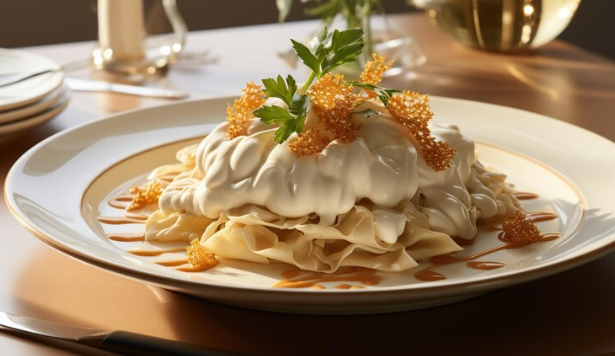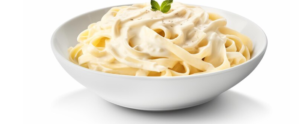Exploring Creamy Italian Sauces
What is the creamy Italian sauce called? Italian cuisine is renowned for its diverse and flavorful sauces, with creamy varieties holding a special place at the table. These sauces, rich and velvety, elevate simple ingredients into indulgent dishes. In this exploration, we focus on iconic creamy sauces like Alfredo, Carbonara, and Bechamel, revealing their culinary secrets and applications. Join us as we delve into the art of these beloved Italian creations, enhancing both your cooking skills and your dining experience.
Overview of Creamy Italian Sauces
What is the creamy Italian sauce called? Italian cuisine is as rich in variety as it is in flavor, particularly when it comes to its creamy sauces. Each sauce, with its unique blend of ingredients and origin story, contributes its own distinctive character to Italian culinary tradition.
Alfredo Sauce
Alfredo sauce is a luxurious blend primarily made from butter and Parmesan cheese, often enriched with cream. Originating from Rome, this sauce was first made famous by restaurateur Alfredo di Lelio in the early 20th century. It’s best known for coating pasta in a rich, velvety embrace, particularly fettuccine.
Carbonara Sauce
Contrary to common misconceptions, traditional Carbonara is not creamy from cream, but from the emulsion of egg yolks, Pecorino Romano cheese, and pasta water. This sauce hails from Rome, crafted as a hearty meal for Italian charcoal workers. It’s often seasoned with black pepper and rendered guanciale or pancetta for a smoky, peppery finish.
Bechamel Sauce
Bechamel, one of the five mother sauces in French cuisine, has been wholeheartedly adopted into Italian cooking, especially for baked dishes like lasagna. Made from a roux of butter and flour, mixed with milk, it is seasoned with nutmeg and sometimes cheese, depending on the recipe’s requirements.
Truffle Cream Sauce
Truffle cream sauce is a more decadent creation, combining heavy cream with the luxurious aroma and flavor of truffles. This sauce is a newer addition to the Italian table, often served with pasta or risotto to elevate the dishes with its rich, earthy undertones.
Each of these sauces showcases the versatility and indulgence of Italian cuisine, bringing creamy textures and deep flavors to the simplest of dishes.
In-Depth Sauce Analysis
This section provides a detailed examination of four popular creamy Italian sauces, exploring their historical origins, key ingredients, and the methods by which they are prepared. Each sauce contributes uniquely to the rich tapestry of Italian cuisine.
Alfredo Sauce
History
Alfredo sauce originated in Rome, Italy, in the early 1900s. Created by Alfredo di Lelio at his restaurant, it was meant to entice his pregnant wife who had lost her appetite. The original recipe, which was simply butter and Parmesan cheese tossed with pasta, became famous when it caught the attention of Hollywood stars.
Ingredients
The classic Alfredo sauce is made with just three main ingredients: butter, heavy cream, and Parmesan cheese. Some modern variations might include garlic, white pepper, or parsley to enhance flavor.
Preparation Method
To prepare Alfredo sauce, melt butter and cream together over low heat. Add grated Parmesan cheese and whisk until the sauce thickens. The sauce is then seasoned with salt and pepper and tossed with pasta, traditionally fettuccine, until well-coated.
Carbonara Sauce
History
Carbonara is a Roman dish that became popular in the mid-20th century. Its name is derived from ‘carbonaro’ (the Italian word for ‘charcoal burner’), suggesting that the dish was a favorite among Italian charcoal workers.
Ingredients
Traditional Carbonara sauce requires few ingredients but precise technique. The core components are eggs, Pecorino Romano cheese, pancetta or guanciale, and black pepper. No cream is used in authentic Carbonara.
Preparation Method
Begin by frying pancetta or guanciale until crisp. In a separate bowl, beat eggs with grated cheese and pepper. Cook pasta, and while still hot, mix it with the egg mixture and cooked pancetta. The heat from the pasta cooks the eggs, forming a creamy sauce.
Bechamel Sauce
History
Though Bechamel is originally a French sauce, it has been adopted into Italian cuisine, primarily as a base for various casseroles and pasta dishes, such as lasagna.
Ingredients
Bechamel sauce is made from a white roux (butter and flour) and milk. Seasonings like salt, nutmeg, and sometimes white pepper are added for flavor.
Preparation Method
Start with melting butter in a saucepan, stir in an equal amount of flour to form a roux, and cook until the mixture turns light golden. Gradually whisk in warm milk to avoid lumps. Continue cooking until the sauce thickens and finish with seasonings.
Truffle Cream Sauce
History
Truffle cream sauce is a modern Italian innovation that capitalizes on the luxurious taste of truffles, which are native to regions of Italy.
Ingredients
The primary ingredients are heavy cream and truffles. Often, a base of sautéed onions or garlic in butter is used, followed by the addition of sliced or minced truffles and cream.
Preparation Method
Begin by gently sautéing onions or garlic in butter. Add finely chopped truffles to the pan, and pour in cream. Simmer the mixture until thickened and season with salt and pepper. Serve over pasta or risotto to enhance the dish with its rich and earthy flavors.
This detailed analysis of each sauce not only highlights their unique characteristics and uses but also invites readers to appreciate and perhaps recreate these quintessential Italian sauces.
Pairings and Recipes
The enjoyment of creamy Italian sauces is greatly enhanced by thoughtful pairings with the right pasta types and wines. This section explores these combinations and provides recipe suggestions to inspire delightful meals.
Best Pasta Pairings
The choice of pasta can transform the dining experience. For Alfredo sauce, fettuccine is traditional because its wide, flat surface beautifully catches the rich sauce. Carbonara typically pairs with spaghetti or bucatini, which the creamy egg sauce clings to effectively. Bechamel is versatile, often used in layered dishes like lasagna or paired with wider noodles like tagliatelle to absorb its mild flavor. For Truffle cream sauce, delicate pastas like tagliolini or pappardelle are ideal as they highlight the luxurious texture and flavor of the truffles without overpowering it.
Wine Pairings
Selecting the right wine can complement and enhance the flavors of these sauces. A crisp, dry white wine like Pinot Grigio pairs well with Alfredo sauce, cutting through its richness. For Carbonara, a light red such as Sangiovese or even a robust white like Chardonnay works well, matching the body of the sauce without overwhelming it. Bechamel-based dishes, being more subtle, go nicely with lighter whites like Sauvignon Blanc. The earthiness of Truffle cream sauce calls for a more aromatic white like a Viognier or a light, fruity red like Pinot Noir.
Recipe Suggestions
For Alfredo sauce, consider a classic Fettuccine Alfredo, adding grilled chicken or shrimp for protein. A traditional Carbonara recipe could be spiced up with a sprinkle of chili flakes or a touch of garlic for those who enjoy a bolder taste. A comforting Bechamel lasagna can incorporate layers of roasted vegetables like zucchini and bell peppers to balance the creamy sauce. For an indulgent meal featuring Truffle cream sauce, try a simple risotto or a homemade truffle cream pizza with a thin crust and minimal toppings to let the sauce shine.
Each of these pairings and recipes is designed to enhance the enjoyment of Italy’s beloved creamy sauces, inviting both novice cooks and seasoned chefs to explore the depths of Italian culinary traditions.



